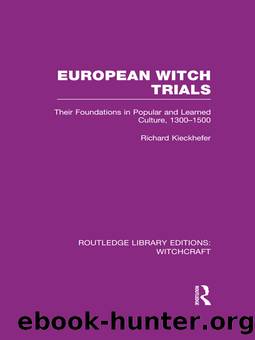European Witch Trials (RLE Witchcraft) by Richard Kieckhefer

Author:Richard Kieckhefer [Kieckhefer, Richard]
Language: eng
Format: epub
Tags: History, General, Social History, Reference
ISBN: 9781136807596
Google: 6omqXE3zFJQC
Publisher: Taylor & Francis
Published: 2012-04-27T15:53:44+00:00
Chapter VIIââConclusion
Historians have typically viewed the Continental witch trials as fundamentally different from those in England. Some have suggested that the specifically popular notion of witchcraft was the same on both sides of the Channel, but differences have unquestionably received more emphasis than similarities. On one point there has been unanimity, either express or tacit: that if there were popular witch accusations on the Continent analogous to those in England, they are lost to history, buried under the excrescences of learned tradition. It is this last thesis that the present work seeks to overturn. It has been suggested here that one can distinguish certain types of record that are superior to others as sources of popular belief, and that by using these documents as touchstones for analysis one can separate folk notions from ideas of the intellectual élite.
The most basic distinctive feature of popular witch beliefs is their thoroughgoing preoccupation with the threat of sorcery. It was in response to this threat that the populace took suspects to court. The cosmological assumptions of the populace were relatively fluid. Long inured to religious practices that seemed to have magical effect, unsophisticated people accepted magical causality alongside natural and religious causal factors; without requiring any detailed explanation of how magic worked, they were willing to accept it as efficacious, and to experiment with various forms of magic. Educated people, on the other hand, and especially those bred on Aristotelian thought, could not accept the idea of distinctively magical causes. When the populace pointed to instances of maleficent magic, growing numbers of intellectuals could only see the influence of Satan. When these learned individuals entered the courtroom, they convicted suspects of diabolismâa charge more serious than that of sorcery, more sensational, and probably punished more frequently with death. First prominent in the Italian courts, the charge of diabolism became important throughout Europe from about 1435 on, in response to the theological literature on witchcraft.
These basic findings are scarcely revolutionary; many historians have assumed for some time that popular and learned notions differed in this way. The contribution that this study attempts to make, however, is twofold. First, it seeks to provide methodologically sound verification for what many scholars have merely presumed on a priori grounds. Without such concrete evidence, one cannot validly exclude those alternative positions that certain other historians have taken for granted: that the people at large were concerned with both sorcery and diabolism, or that diabolism actually was practiced on a wide scale. Second, the present work endeavors to draw further and more detailed comparisons between popular and learned tradition. Reflecting directly the conceptions of theological literature, the accusations set forth by judges portray the witch as closely allied with the devil: he gives her the material means for bewitchment (unguents, powders, etc.), instructs her in their use, orders her to employ them to afflict her neighbors, and otherwise aids and abets her malfeasance. This involvement of the devil in the act of sorcery is almost wholly absent from texts which bear the mark of popular tradition.
Download
This site does not store any files on its server. We only index and link to content provided by other sites. Please contact the content providers to delete copyright contents if any and email us, we'll remove relevant links or contents immediately.
Constitutional Law by Erwin Chemerinsky;(155)
Sentencing and Artificial Intelligence by Ryberg Jesper;Roberts Julian V.;(150)
European Witch Trials (RLE Witchcraft) by Richard Kieckhefer(147)
Solve Your Money Troubles by Amy Loftsgordon;Cara O'Neill;(146)
Roman Law and Economics by unknow(132)
Dictionary of American Criminal Justice by Dean J. Champion(129)
Juvenile Risk and Needs Assessment by Christopher J. Sullivan Kristina K. Childs(127)
Policing the Police : Knowledge Management in Law Enforcement by Petter Gottschalk(125)
Incarceration without Conviction by Mikaela Rabinowitz(119)
The Supreme Court's Role in Mass Incarceration by William T. Pizzi(118)
A Constitution for the Living by Beau Breslin(117)
The Eternal Criminal Record by James B. Jacobs(116)
The Legal Guide for Museum Professionals by Courtney Julia;(116)
Lawyers, Lead On by Williford Rebecca S.;Basas Carrie A.;Enyart Stephanie L.;(112)
Law for Student Police Officers by Merritt Jonathan;(111)
Crime and the Life Course by Michael L. Benson(109)
Zionism, Palestinian Nationalism and the Law: 1939-1948 by Steven E Zipperstein(109)
Revitalizing Victimization Theory by Travis C. Pratt Jillian J. Turanovic(104)
Juvenile Homicides : A Social Disorganization Perspective by Minna K. Laurikkala(103)
